How Pressure Cookers Actually Work
Everything you need to know about how pressure cookers work!
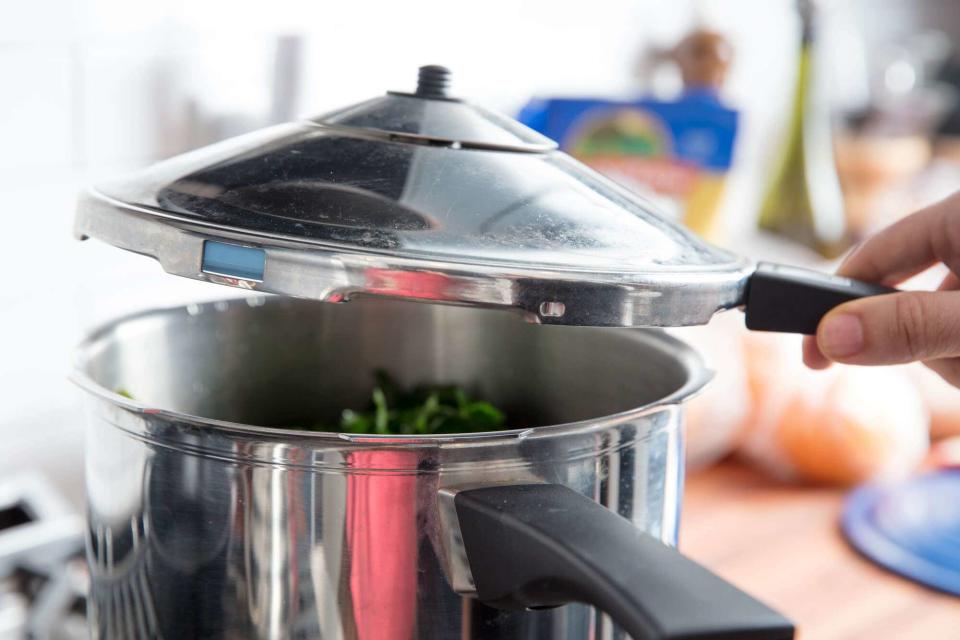
Serious Eats / Vicky Wasik
Say the words “pressure cooker” to someone who’s never used one, and they’ll probably think “danger.” It isn’t hard to imagine what’s going through their heads—visions of flying lids, exploding kettles, or much, much worse. Even people who have used a pressure cooker will sometimes get a little leery around one.
But while such hazards may have been possible in the past, they’re practically fiction today. Pressure cookers are safe to use. More than that, they’re incredibly useful. In this age of speed, efficiency, and optimization, there are few tools in the kitchen more suited to cooks who demand good food quickly. If you’re on the fence about buying a pressure cooker—or if you’re an especially obstinate hater, this article is for you.
A Brief History of Pressure Cooking
The origins of the pressure cooker can be traced to a 17th-century French physicist and mathematician named Denis Papin. Papin, who shared notes with such legendary brainiacs as Christiaan Huygens, Gottfried Leibniz, and Robert Boyle, is best known for his 1679 invention of the “steam digester,” the precursor to both the pressure cooker and the steam engine. Also known as the “bone digester” (such a hardcore name!) or “Papin’s digester,” the device was designed to extract fats and collagen from bones; after extraction, the rendered bones could be ground into bone meal, to be used as a dietary supplement or fertilizer.
The steam digester consisted of a closed pot with a tight-fitting lid. As food and water heated up, the vessel trapped steam, raising the pot's internal pressure. Papin’s initial designs didn’t include any pressure-release mechanism, which resulted in various explosions early on. Fortunately, Papin subsequently invented a steam-release valve to keep such accidents from happening.
Over the next 200 years, intrepid minds refined the concept. But it wasn’t until the 1930s that the pressure cooker finally made its way into the home kitchen, with the introduction of Alfred Vischer’s “Flex-Seal Speed Cooker” in 1938, and later a model from the National Pressure Cooker Company (which is now named National Presto Industries and is still very much in the pressure cooker game) in 1939.
Since then, not much has changed, and pressure cooker designs can be classified by generations. The first and simplest “old type” pressure cookers feature a weighted “jiggler” valve that releases and regulates pressure, causing a rattling noise as steam escapes. Today, most pressure cookers you can find are first-generation designs, with small safety improvements like pressure-sensitive locking mechanisms, as well as the ability to adjust pressure by changing the weight of the valve.
Second-generation pressure cookers are quieter, have a hidden, spring-loaded valve, and allow you to choose at least two different pressure settings by adjusting a dial. Some cookers don’t even release any steam while cooking; instead, they have an indicator that displays the pressure level. Overall, second-generation models offer more precision when cooking than do first-generation models.
Third-generation models are a relatively recent innovation. Unlike models belonging to the first two generations, these models all have an electric heat source that maintains proper pressure while cooking. They typically have a timer, and more elaborate models include digital controllers, delayed cooking functionality, and smart programming for cooking certain foods.
But What About Those Explosions?
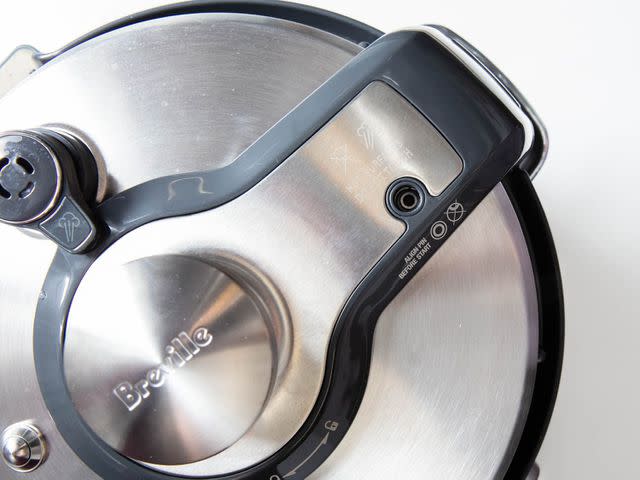
Serious Eats / Vicky Wasik
Legends of exploding pressure cookers aren't entirely unfounded. As the US entered World War II, the government promoted self-sufficiency programs, which encouraged canning home-grown produce. Steel was allocated for the production of pressure canners, and the popularity of pressure cookers rose as well. After the war, demand for pressure cookers was at an all-time high, precipitating a boom in production. Manufacturers began pumping out pressure cookers, but at the expense of materials, construction, and overall safety. For instance, models from the '50s had a single, poorly constructed weighted valve that easily clogged with debris. As pressure built to an extreme, the gasket would blow, and water or steam would spew from the top; in some cases, the lid would just fly right off.
Fortunately, manufacturing and design practices have improved considerably, and today’s pressure cookers feature several fail-safe mechanisms to ensure safety, such as multiple valves, dual pressure regulators, and spring-loaded lid locks. No more sketchy deathtraps.
How Do Pressure Cookers Work?
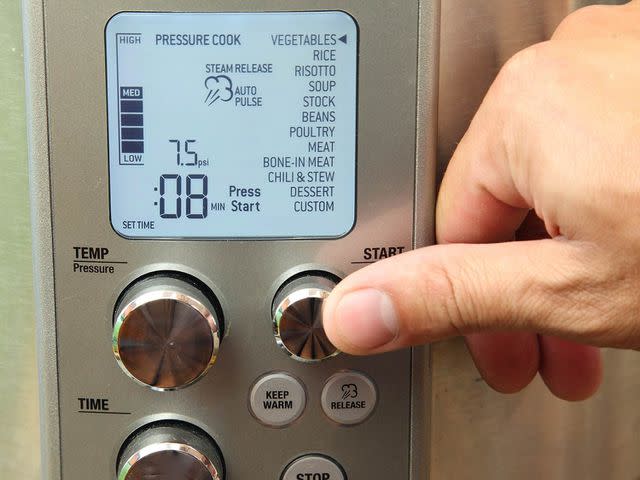
Serious Eats / Vicky Wasik
A pressure cooker is a sealed chamber that traps the steam generated as its contents are heated. As steam builds, pressure increases, driving the boiling point of water past 212°F (100°C). In general, this higher temperature shortens cooking times and, due to a lack of evaporation, extracts flavor more efficiently from foods.
The Science Behind Pressure Cookers
Time for a quick high school chemistry refresher: The pressure cooker can be best explained by the “ideal gas law” (or “general gas equation”), which describes the behavior of most gases under most conditions. It is commonly given as: PV = nRT
P stands for pressure; V stands for volume; T stands for temperature; n represents the amount of a given gas (expressed as a number of particles); and R represents a constant (the ideal gas constant, but, for the sake of simplicity, let’s say that’s not too important here).
In the closed chamber of a pressure cooker, we can make a few assumptions. For one, the volume (V) of the chamber doesn’t change. Second, R (being a constant) doesn’t change either. Third, there is a maximum pressure that the chamber can reach, regulated by a valve system. As the pressure cooker heats food up (i.e., heats water in the food), T goes up. And as T increases, something else must increase to balance the equation. Since we assume that V is constant, it is more than likely that pressure (P) increases as well.
We can explain this increase in pressure another way, too: As the system heats up, there is more energy supplied to molecules of water vapor, which causes them to bounce around and collide randomly both with each other and against the walls of the container. The force of these collisions against the walls is one definition of pressure, based on the “kinetic model of gases.”
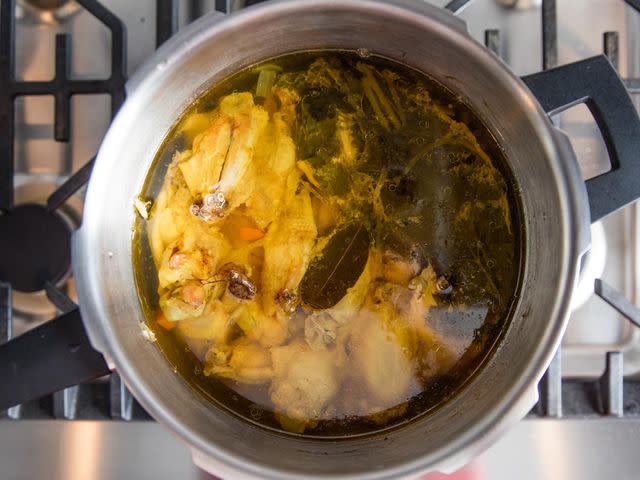
Serious Eats / Vicky Wasik
But what happens when P maxes out? Consider, for a moment, a pressure cooker containing water and chicken bones for making stock. As the container reaches maximum pressure, the temperature (T) plateaus. If we continue to supply heat (energy) to the system, then we’re still providing energy for more random collisions between water molecules. In the absence of a valve, the water would continue to heat up, building pressure indefinitely. But something has to give. In this case, n (the amount of gas) decreases. We see this in the form of steam escaping slightly, making the pressure-regulating valve rattle as our chicken stock cooks. This is the case for first-generation stove-top cookers. For newer, third-generation electric models, the cooker detects both pressure and temperature and regulates the amount of heat supplied by the heating element, so you don’t see much steam escaping or hear much rattling.
What It All Boils Down To
Practically speaking, what all that science amounts to is this: In a sealed pressure cooker, the boiling point of water goes up as pressure increases.
At standard atmospheric pressure, the boiling point of water is 212°F (100°C). But in a standard American pressure cooker, the pressure reaches 1 atm or 15 psi (pounds per square inch) above standard atmospheric pressure*, or 2 atm, which is typically the maximum pressure limit on most cookers. At 30 psi, the boiling point of water is about 250°F (121°C).
*The reading on the gauge for nearly every pressure cooker indicates the pressure above atmospheric pressure. At sea level, atmospheric pressure is about 1 atm, or 15 psi. If a dial reads 15 psi, then that means the pressure inside the sealed chamber is 15 psi above atmospheric 15 psi (30 psi total, referred to as “absolute pressure”). This dial reading is technically referred to as “gauge pressure.”
The higher cooking temperature in a sealed pressure cooker means, in general, faster cooking without burning food. And, because the vessel is sealed, it also limits evaporation of critical volatile flavor and aroma compounds. An added plus: the contents of a pressure cooker go relatively undisturbed, since the liquid never effectively boils.
Using a Pressure Cooker at High Elevation
What about pressure cooking above sea level? You might be aware that general cooking times and temperatures for certain recipes differ in places like Denver, CO, or high up in the Andes. At high altitudes, the atmospheric pressure is lower**. For example, in Denver, the ambient pressure is around 12.2 psi.
** Pressure is lower at higher elevations because most of the air molecules in the atmosphere are held close to the earth’s surface by gravity, which means there are fewer air molecules above a higher altitude surface than there are above a surface at a lower altitude.
In general, a pressure cooker adds pressure above the given atmospheric pressure. That means the force that closes the valve as pressure builds in the chamber includes the force of atmospheric pressure. For example, if the atmospheric pressure in Denver is 12.2 psi, then the absolute pressure of the chamber at full pressure is 27.2 (12.2 psi + 15 psi)—nearly 3 psi less than at sea level. Looking at our trusty ideal gas equation, we know that lowering pressure will lower the temperature in a system. In this case, the boiling point of water in a sealed chamber cooking at high pressure will be 244.8°F, almost 6 degrees lower than the same system at sea level.
Of course, a lower boiling point means slower cooking. What does that mean for you? It means you have to increase cooking time to accommodate lower pressure and lower cooking temperature in order to get the same results. A good rule of thumb is to increase cooking time by about five percent for every 1000 feet above 2000 feet elevation.
Choosing the Right Cooker: A Difference in psi
Here in America, you have a greater choice to make when it comes to pressure cookers: electric or stovetop? There are several advantages and disadvantages to using either design. But the single biggest difference is this: Electric pressure cookers operate at lower pressure (12 psi) than their stovetop counterparts (15 psi). Once again, lower pressure means lower temperature, so cooking times will be longer when using an electric model.
Why would you want to cook at lower pressure, and cook slower? The tradeoff is convenience and safety. Electric pressure cookers build pressure up to 15 psi, but maintain a lower pressure during cooking, removing any need to monitor heat. Just like the Ronco Showtime Rotisserie 4000, you can just “set it and forget it.”
How to Cool a Pressure Cooker Down
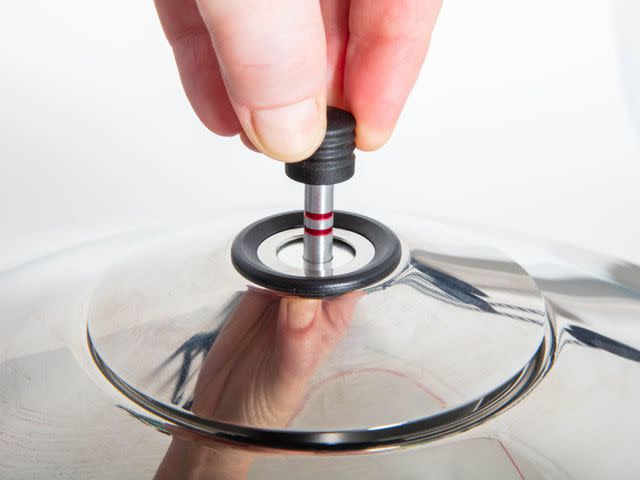
Serious Eats / Vicky Wasik
There are three main methods for bringing the pressure in a cooker back down: natural release, quick release, and cold water release.
Natural release involves taking the cooker off heat and allowing the temperature to gradually decrease until the spring-loaded lock disengages. Keep in mind that there could be significant carryover cooking with a natural release technique, depending on how much food you’re cooking.
Quick release, as the name implies, involves removing the weighted jiggler or pressing a button to allow steam inside the cooker to escape. Doing so allows you to stop the cooking immediately, but it also means that the contents of the pressure cooker will boil vigorously. Kenji takes advantage of that boiling to effectively blend his pressure cooker split pea soup without using a blender.
Lastly, there’s the cold water release, which requires running the entire apparatus under cold running water until the cooker depressurizes and the lock disengages. Like the quick release method, the cold water release allows you to access your food effectively immediately. On the other hand, this method doesn’t cause the contents to vigorously boil, which might be desirable for a given recipe. Be aware that the cold water release can’t be used on electric models.
Pressure Power
As the writer Andrew Smith once said, “People fear what they don’t understand (and anything that might blow up in their faces)."*** Hopefully this article has convinced you a pressure cooker won’t blow up in your face, and given you some useful information about how they operate and why they deserve a place in your kitchen.
When you get right down to it, using a modern pressure cooker is about as safe as boiling a pot of water. And when used with care and attention, they can elevate your cooking to greater and tastier heights. But that’s best left for another article, so stay tuned.
***Okay, he didn’t say the part in parentheses.

